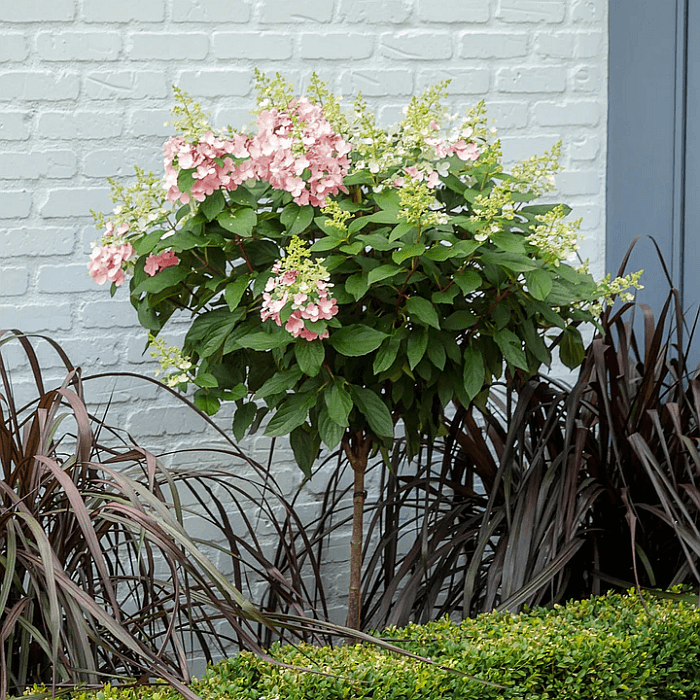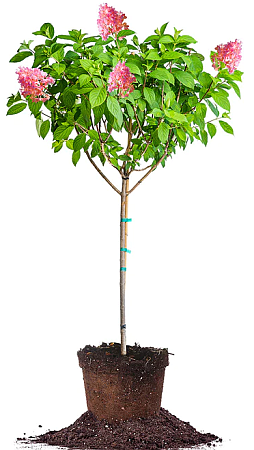This post may contain affiliate links. As an Amazon Associate we earn from qualifying purchases.
Panicle hydrangea pruning helps it bloom spectacularly.
This is the time of year when panicle hydrangea (Hydrangea paniculata) fans start getting excited. Before we know it, these easy-growing shrubs will be in bloom, in all their gorgeous splendor.
But (there’s usually a “but,” right?), they won’t bloom as spectacularly as they’re capable of if they aren’t pruned, if needed, and pruned correctly.
So, let’s get started on the ins and outs of panicle hydrangea pruning.
What happens if you don’t prune panicle hydrangeas?
Some trees and shrubs bloom on old wood (growth from last season) while others will only bloom on new wood.
Even cultivars within the same genus may vary in their preference. For instance, in the Hydrangea genus, oakleaf, bigleaf, mountain and climbing hydrangeas bloom on old wood.
These hydrangeas shouldn’t be pruned unless absolutely necessary or you’ll risk ruining the upcoming blooming season.
Smooth hydrangea and the panicle hydrangea bloom on new wood (that which is produced in the current season).
If you don’t prune panicle hydrangeas they will still bloom. After all, it should be producing new growth on which buds will grow.

When should I prune panicle hydrangeas?
Good question. Here’s another aspect of this plant to love: it really doesn’t care if and when you prune it.
Well, that’s a bit general. You probably won’t please it if you take your pruners to it in the dead of winter.
The ideal time? Although late winter is an acceptable time, a surprise frost could ruin your dreams of a flower-laden hydrangea shrub later in the season.
Aim for early spring, well after the last frost date and when the shrub is just starting to produce new leaves.

How to prune a panicle hydrangea
Time to get out the pruners. If you need to shop for new ones, we recommend the award-winning Felco F2’s as they’re less likely to crush stems. But they must be sharp, so take on this task first.
Don’t know where to start? Check out this pruner sharpening video from Jason at Fraser Valley Rose Farm.
After sharpening, you’ll want to ensure that the blades are free from anything that might infect or infest your panicle hydrangea. A dip in a good household disinfectant (such as Lysol) will do the trick.
If you’ve ever pruned a rose bush you will have no problem with this hydrangea.
To figure out where to cut, follow the stem down toward the soil until you find a live bud.
Make your cut ¼ inch above this point. Continue around the shrub until you’ve removed no more than one-third of the current growth.
It’s also a good idea to wipe the blades between cuts. For that task, we like these Lysol Disinfectant Wipes, available at Amazon.
How do you prune an overgrown paniculata hydrangea?
If your panicle hydrangea has reached monstrous proportions, you can bring it back to reality with a good pruning.
This will be a gradual process, however so patience is required.
Depending on how large it’s grown, you may need a pair of bypass long-handle loppers.
Remove one-third of the oldest branches all the way to the soil. In the following spring, remove half of what’s left of older stems and then the year after, remove the remaining.

How to prune panicle hydrangea into a tree?
Panicle hydrangeas make lovely trees. And, although the process isn’t difficult, it is a bit time consuming.
Start at the bottom of the shrub, removing branches all the way back to a main stem. Depending on the size of your panicle hydrangea, this may involve crawling underneath it to get to those branches.
Work your way around the hydrangea shrub and then upwards until the trunks are exposed to your liking.
Many gardeners prefer the “standard” look. A standard, be it rose, hydrangea or other plant, is one that has a single main stem.
Stand back and take a look at the panicle shrub. Again, if it’s overgrown, you may need to get under it and check out the main stems from there.
Look for the straightest stem, pointing upright, that you can find.
This will eventually be the trunk, so be mindful of that when choosing what is known as the soon-to-be a tree’s “central leader.” Not only should it be straight, but strong as well.
Take off all other branches along the lower two thirds of the central leader, by cutting them to the soil.
Finally, tie the main stem to a stake with soft ties placed every three to four inches.
Check the panicle hydrangea over the course of the growing season and remove any growth from the soil or the central leader that is lower than the new canopy you created.
If this all sounds like more time and energy than you prefer, you can purchase a hydrangea paniculata that is already in tree form. Check out the selection at Perfect Plants Nursery.
And, be sure to check out our great-big guide to Everything you Need to Know About Growing Hydrangea.



